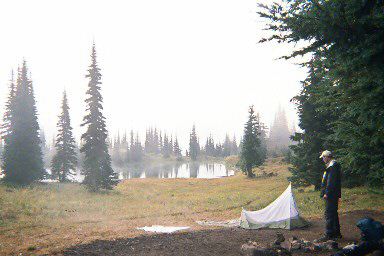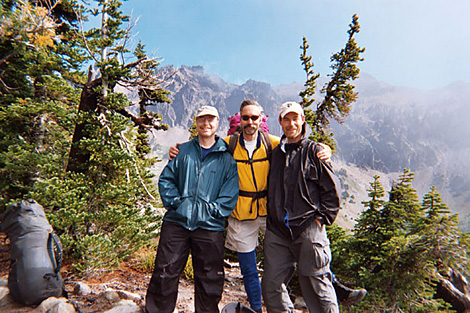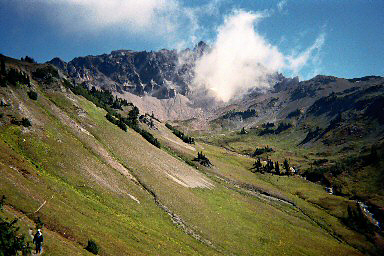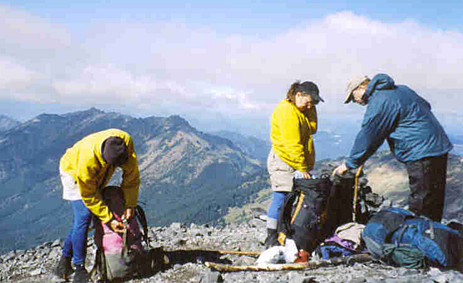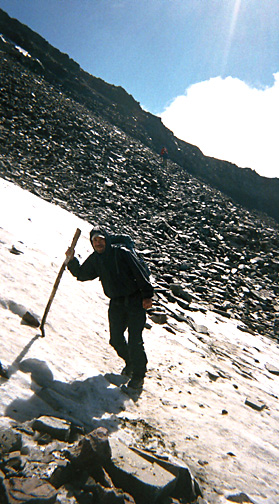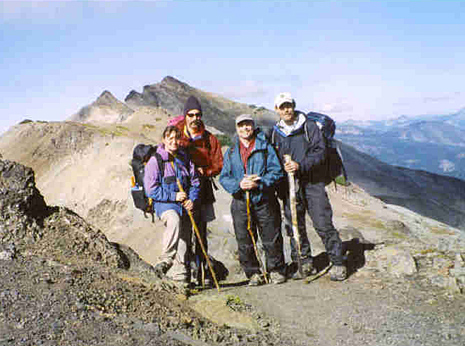Day Fourteen
Sheep Lake to Elk Pass campsite
9.5 miles
Summary: This is one of the most scenic stretches of the Pacific Crest Trail anywhere along its 2,560-mile journey from Mexico to Canada. After crossing Cispus Pass, you are in the headwaters of the Cispus River, an alpine garden of waterfalls, streams, flowers and colors of green you've never experienced before. Then a short hike above Snowgrass Flats takes you to the approach to the Knife's Edge. You journey up to 7,080 feet at the ridge near Old Snowy Mountain, cross a glacier and walk for about 3 1/2 miles along the crest line, with mountainsides plunging off to the right and left.
I had been telling my hiking partners about the Knife's Edge since we began planning this trip. If the weather didn't improve, they wouldn't even be able to see it. If it did, could it live up to its hype?
We woke up to cloudy skies again, but more wind. Kevin was optimistic. "I think it will clear," he declared. "I expected fog in the morning." It seemed, by a force of will, he was going to part the clouds and let the sun in. Of the four of us, he was the one who most intensely wanted to see the rugged beauty ahead.
And his willpower worked. As we were packing up, patches of sunshine broke through the cloud cover. I even set the tent out in a field for a few minutes in the hope of getting it drier. It was anything but sunny, but showed promise of bluer skies. We left in the lake in our best mood in days.
Kevin stands next to our drying tent with Sheep Lake in the background. Most of the time it was too foggy to even seen the lake. |
As we climbed up to 6,400 foot Cispus Pass, the weather was changing. The closer we go to the top, the more the clouds dissipated. A huge wall of the Goat Rocks and Gilbert Peak came into view. The morning sun hit it sharply, with the air so clear we seemed to be living in hyper-reality. We stopped to take photos--including a shot of the three guys on the trip by Beth. I wasn't sure that the weather would hold so I got out my camera and I took several shots.
The "Three Amigos" at the Goat Rocks. Left to right, Tom, Chuck and Kevin. |
The climb up was tougher than I remembered, but the gardens on the other side of the pass were just as divine as I recalled. Ten or 20 little streams poured down the sides of the ridges to form the headwaters of the Cispus River. No film could capture the intensity of the green. No one really wanted to leave it. We called it "God's Garden."
The headwaters of the Cispus River are God's garden. |
At a waterfall by the trailside I pretended I was filling my waterbottle in the cascade. The bubbling and gurgling sounds were a refreshing change from raindrops. For once, water was our friend instead of our enemy. As we hiked along the north side of the river valley, we passed three spectacular campsites with fabulous views along the trail. If the weather had been fine, we would have camped here last night. But our plan to rest on Day 13 and wait for clearing was right--now we were basking in the sunshine.
We had lunch at the trail junction to Snowgrass Flat. I suggested that we each find a hiking stick for the next segment while we were still walking in the trees. We were coming to a tricky glacier crossing, and a hiking stick would help us keep our balance on the snow and ice, I explained.
I needed the stick just for the approach to the Edge. I had forgotten how steep and barren the trail was at this point. Much of it was on scree and through boulder fields. I wasn't sure how someone could navigate this section in fog and rain. There weren't many landmarks. As we got higher, Mt. Adams should have come into view, but the clouds covered our mountain while I was climbing. Kevin was luckier and saw it emerge from the clouds a few minutes later.
We are checking our gear before going over the "Edge." |
As usual, I hiked ahead of the rest, but I was determined we would cross the Knife's Edge together. So at the top of the approach, just before the trail swings along the side of a bowl to get to the crest line, I dropped my pack and waited. It was cold but sunny. Clouds swiftly moved in and out of the valleys. I could see Mt. Rainier at one point and a high mountain lake called, what else, Goat Lake.
While I waited, I decided to check out the Packwood Glacier glacier crossing. With Tim Dean in 2002, its length had been 35 feet across the snow. The glacier is on the side of a steep bowl; one slip and you could be headed for rocks below. When I got to it, I found the hot summer had melted most of it away. What was left had rocks poking through except for about 10-15 feet of snow and ice. This was going to be easy, I thought.
I hiked back to the ridge top. Soon Kevin appeared and then about five minutes later came Chuck and Beth. Everyone gasped when they got to the ridge crest--and not because they were out of breath. Everywhere there were unimaginable views--mountains, glaciers, valleys, rivers, lakes, clouds, sky, snow. We could see the challenge of the Knife's Edge ahead. We were on the top of the world.
Kevin leans on his hiking stick as he crosses the glacier. |
Now came the long traverse to the glacier crossing. I told Kevin, Chuck and Beth the good news: the glacier crossing was much easier than usual. I scampered across first. Then came Kevin, who posed for the camera as he was crossing the most difficult spot. Beth was not certain she wanted to try it. She thought about crossing below the glacier, in the rock fields. But just starting off in the that direction dissuaded her. It was rough going and the rocks were loose.
"I can carry your pack," I offered. I dropped my pack, crossed the snow and ice, and picked up Beth's much lighter pack. Then I crossed back, slipping slightly on the ice but trusting my balance and my hiking stick. Beth and Chuck followed. Now we were set for the next adventure.
The Knife's Edge was as I remembered it. The trail is built at the top of a sharp crest, with steep drop offs to your right and to your left. You are not always directly on the crestline, but you always seem to be on the edge of the mountain. A bad slip and you could get killed tumbling down the side. It is not a place for someone with vertigo. This time I went slowly to take it all in.
We stand on the Edge: Beth, Chuck, Tom, Kevin. |
The trail follows the edge of the crest. |
The four of us were doing very well. We traded cameras to take shots of the foursome and the scenery. At one point we saw a mountain goat hike down McCall Glacier. After all the talk, the landscape exceeded its reputation. "You feel like you are on the edge of the Earth," Kevin said.
I didn't want to leave, yet hiking in these conditions are intense. Every step takes a certain amount of concentration. You spend a lot of time looking down to make sure your footing is secure. It was already late afternoon and I knew the best campsite was still a few miles away. But it would be absurd to hurry along.
At last we were at the trail junction at Elk Pass, the end of the Knife's Edge section of the trail. We took some photos to celebrate and then I told our crew that we had to march on. I said the next one or two miles were steep downhill trail and that my hiking partner last year had twisted his ankle on a wicked stretch of glacial gravel. "Be careful and take your time," I warned them.
I set out ahead again to find the campsite Tim and I had used the year before. It was lower than some of the first sites we saw, which meant it would be sheltered from winds off the ridge. It was also next to a mountain creek for water. We needed to get there before it got too dark to dry out our tents.
As I made my way, the campsite seemed farther away than I imagined. I think I was getting tired and just didn't estimate the distances very well. Finally I saw it about 100 yards below me. In my haste, I slipped right on the patch of glacial gravel I had warned the others about! Fortunately I landed on my butt and didn't twist an ankle.
I got to the site, which was off trail but clearly visible coming down the mountainside. Already the sun was behind the ridge, but I got out my tent anyway to dry it out. It was getting colder and I quickly put on most of my warm clothes and a wool cap. I could see Kevin above on the trail, and then above him Chuck and Beth. It looked like we were all going to make it just fine.
I turned my attention to camp chores. When I looked up, Chuck was walking into the camp. "Hi Chuck, where's Kevin?" I asked. "I don't know. He was ahead of me," Chuck replied. I looked up the hillside but saw only Beth coming down.
That meant that Kevin had missed the campsite and continued down the trail. Chuck and I both started yelling his name as loud as we could. Chuck offered to go after him but I said I'd do it, since I had rested a little bit. As I started down the trail, we yelled again and heard him reply. Thank God he was still in earshot. Soon we were reunited at the site.
By this time we were all tired and I grew a little crabby. Our gas canisters were cold and the stove wasn't working very well. We had to warm up the canisters with our body heat to get them to work well. At last we got a pot of water boiling for our freeze-dried meal of beef stew. It was a good idea to save it for the last dinner--it was easy and quick to make.
As it got darker, a horse party came down the trail from Elks Pass. We couldn't believe that they had taken horses over the Knife's Edge, but they had. One horse slipped on the glacier, slid to the rocks and cut his leg. Beth, who knows a lot about horses, was concerned. They asked if they could share the camp area and of course we said yes. It was a large field with plenty of room for the tents and horses. We chatted with the leaders and they said if they had known how hard the Knife's Edge was going to be, they never would have crossed it. I was amazed that they did.
So this was our last night. Traditionally we should sit by the campfire
and tell each other stories about the trip, I said. But everyone was too
tired for that. We crept into our sleeping bags instead and got ready for
the coldest night of the trip.
Day Fifteen
Return to Tom's PCT Page
